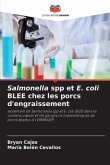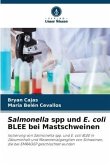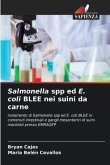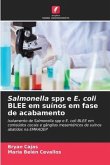Salmonella spp and E. coli BLEE are bacteria of great importance in public health due to their involvement in both foodborne diseases and antimicrobial resistance. The main objective of the present investigation was to isolate Salmonella spp and E. coli BLEE from cecal contents and mesenteric ganglia, from pigs slaughtered at EMRAQ-EP and to statistically associate these isolates with the place of origin of the pigs. A total of 365 samples were taken from cecums and mesenteric ganglia in the pig evisceration area. For the microbiological analysis of Salmonella spp. the methodology proposed in ISO 6579 was used, and ISO 16649 was applied for the determination of E. coli BLEE. A total of 56 (15.3%) and 347 (95%) isolates of Salmonella spp. and E. coli BLEE were obtained, respectively. The Chi-square test showed no statistical significance between the presence of Salmonella spp. and E. coli BLEE in cecal contents and mesenteric ganglia and the geographic site of origin of the pigs sampled (p>0.05).
Bitte wählen Sie Ihr Anliegen aus.
Rechnungen
Retourenschein anfordern
Bestellstatus
Storno








